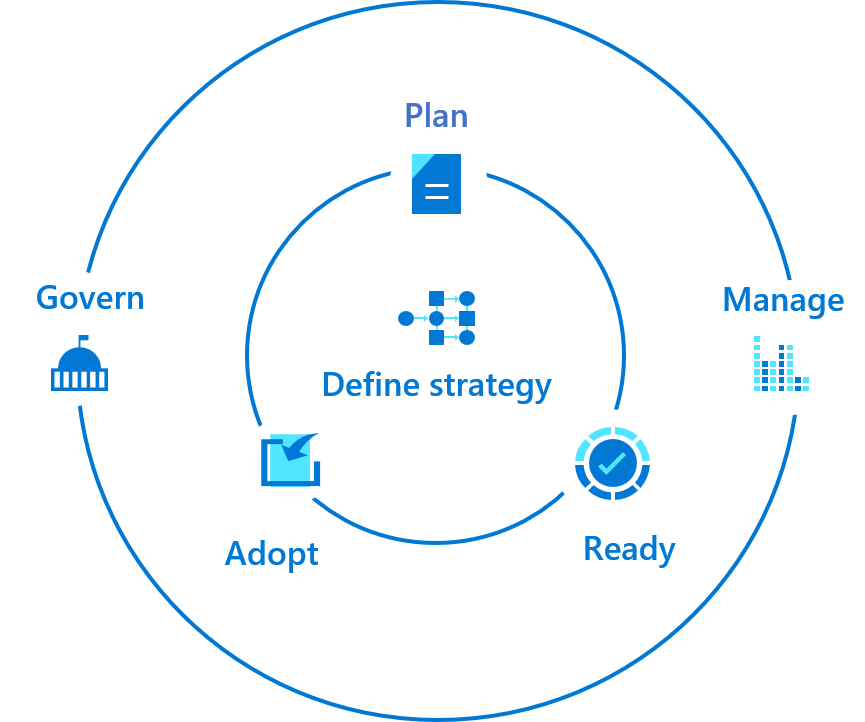Do you already know about the Microsoft Cloud Adoption Framework? It is a proven guidance designed to assist you in developing and implementing the business and technology strategies needed for your company to be successful in the cloud. The framework offers best practices, data and resources that cloud developers, IT experts and business decision makers need to achieve their desired business outcomes. This standardized approach also helps to ensure greater coordination between company and technological strategies. Here are five reasons why you definitely should use a Cloud Adoption Framework.

1. Governance: budgetary control and access rights
One of the most critical aspects of your IT environment is keeping a tight grasp on the budget. In the cloud this may be even more relevant. The Cloud Adoption Framework enables you to apply governance at scale to your cloud environment in a controlled manner, preventing unwelcome surprises on your monthly statement.
When you grant application teams complete freedom, you may end up with very expensive cloud resources. While that is not always necessary. The framework helps clarify the cost flows, establishes budgets, directs access rights and restricts the use of certain resources when they are not in line with your policy. This way, you can keep a close eye on costs and access management within your cloud platform.
2. Cloud Adoption Framework ensures security and compliance
The more you work in the cloud, the more important it is to work safely and in accordance with GDPR. The framework gives you guidance in setting up (policy driven) guard rails on your cloud environment. By doing this, all your cloud solutions are secure and compliant by default.
In ‘old fashioned’ IT, environment security was implemented at the highest level. It was difficult to apply different levels of security for different solutions. This led to (unnecessary) high costs and probably a degraded level of functionality and usability. The Cloud Adoption Framework guides you in setting up an application centric approach. Now, you can work with a standard level of security that applies to all applications and then add additional security measures for specific components. This is referred to as layered defence. Within that framework, you can give the application team complete freedom to do their work.
3. A holistic approach with the Cloud Adoption Framework
Cloud adoption starts well before the selection of a cloud application provider. It begins when business and IT decision makers understand that the cloud will assist them in accomplishing a particular business transformation goal. Therefore, the platform is a full lifecycle framework for cloud adoption which goes beyond technology. From defining your strategy and objectives to actually setting up your cloud environment and providing code templates: the Cloud Adoption Framework assists organizations in aligning their business, culture and technological transformation in order to successfully achieve short-term and long-term objectives.
4. Applicable for large and small companies
The overall Cloud Adoption Framework is an extensive system with many processes. As an enterprise organization, you can use the entire framework in your organization and cloud environment from start to finish. However, even as a small business, you can easily use an aspect of the framework and extend it to more elements. We also use the Cloud Adoption Framework at a large retailer to set up the Azure platform, but also at smaller businesses, for example, to organize security. The framework has been demonstrated to be appropriate for any type of organization of any scale.
5. Quick results using the Cloud Adoption Framework
When you use the framework, you do not have to reinvent the wheel when it comes to configuring your Azure platform. Furthermore, you can be sure that you are using the cloud in the way that Microsoft intended and that best practices are being followed. We also use the Cloud Adoption Framework templates and specify them for the customer, which saves a lot of time. As a result, you have a cloud infrastructure that is optimally built and that allows you to get the most out of it. You are capable of being innovative with a scalable and future-oriented platform without compromising security, costs and privacy.